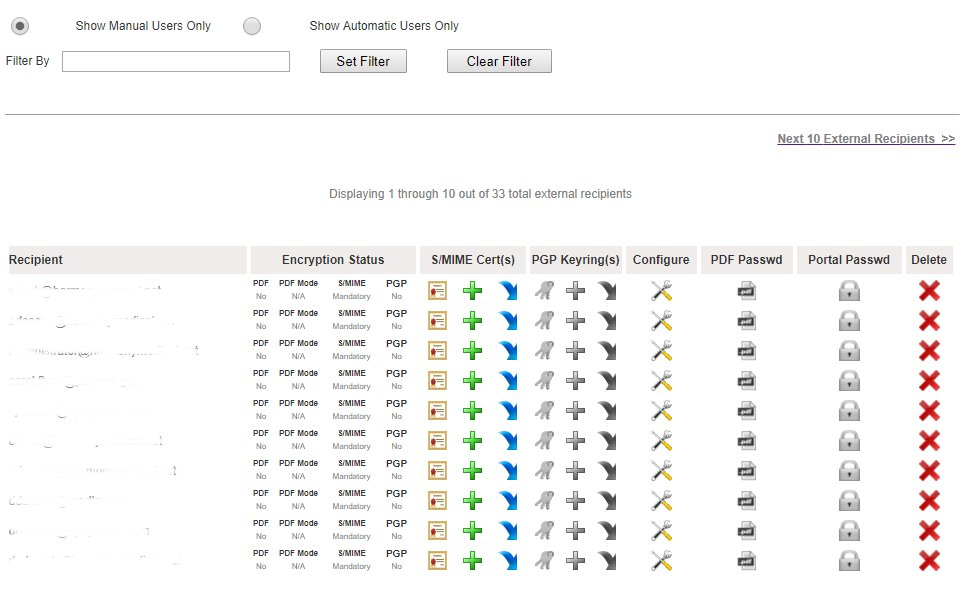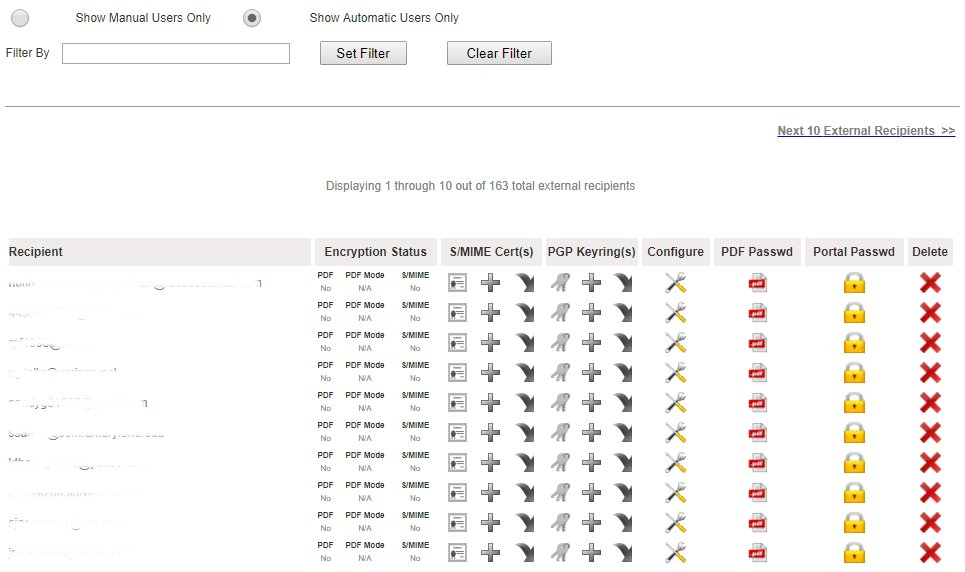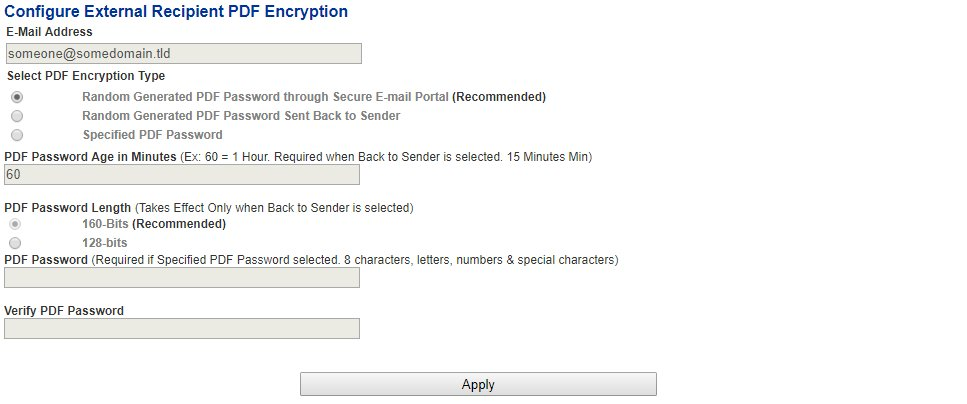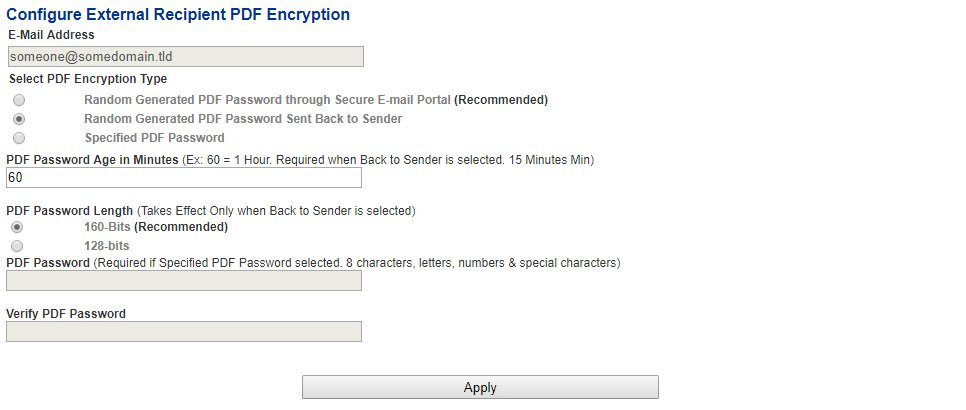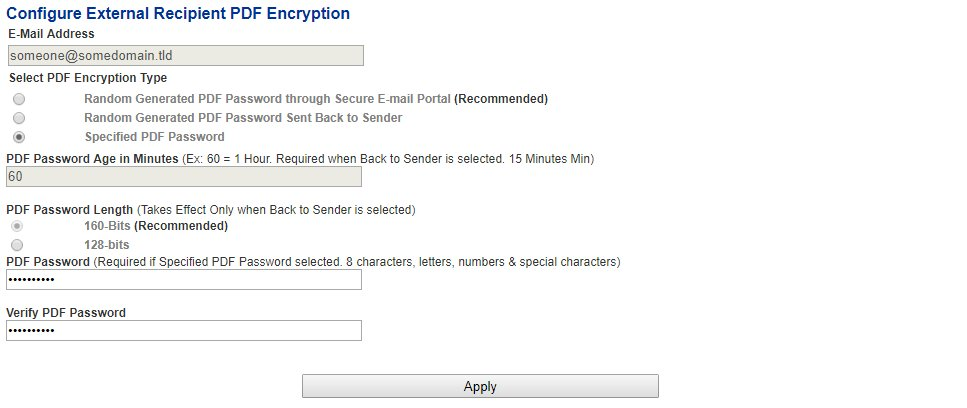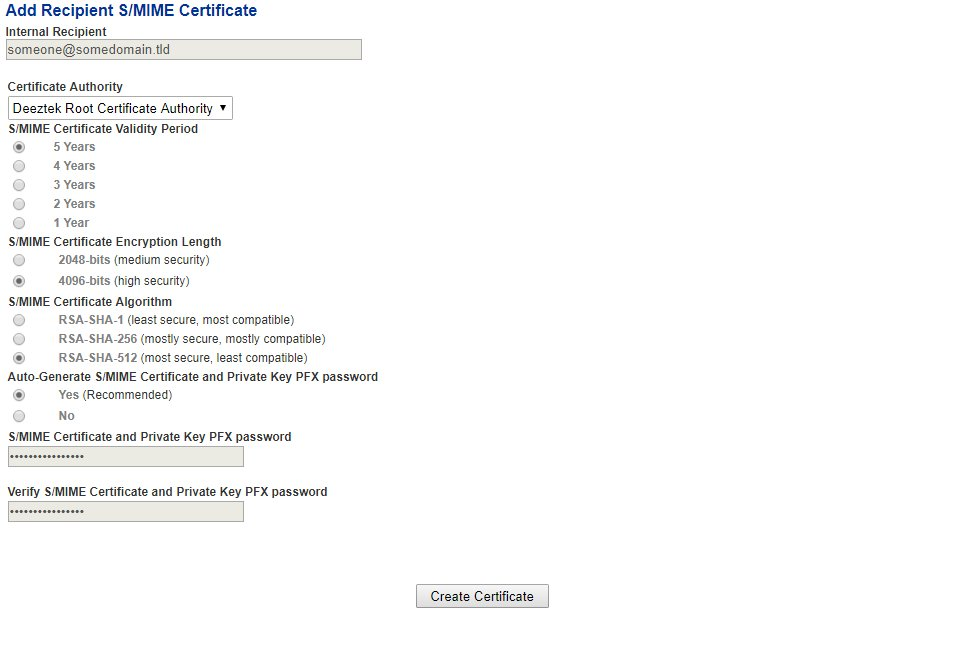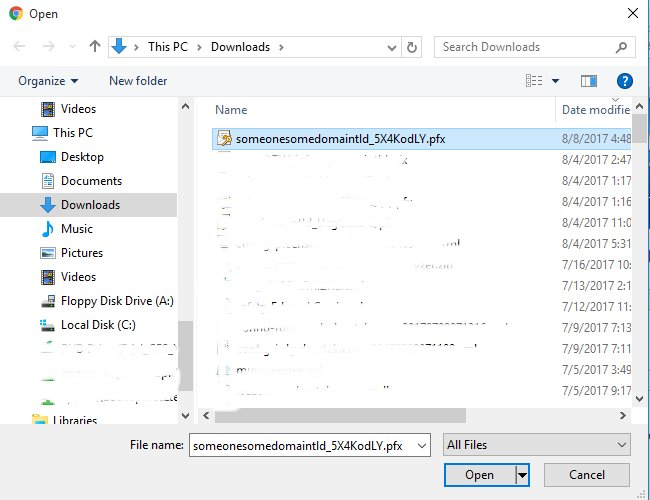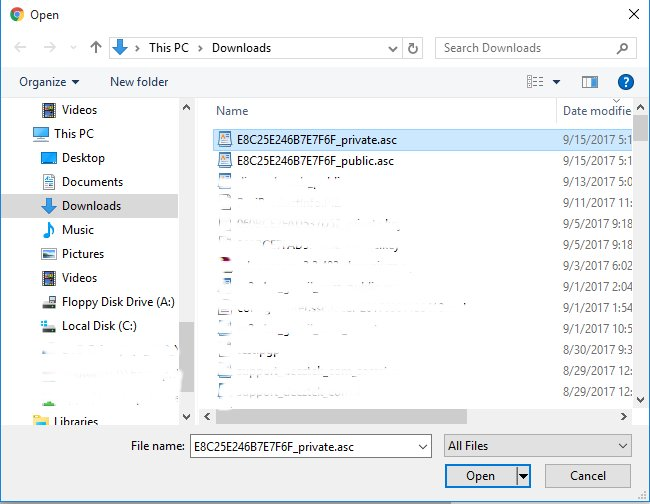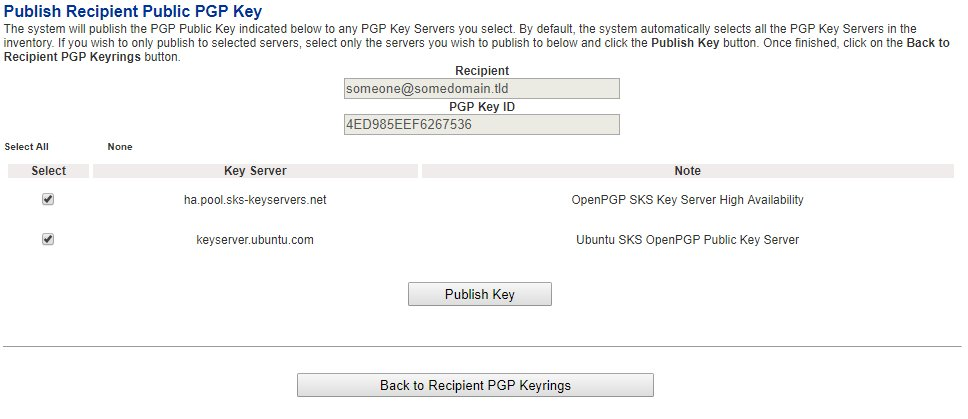External Recipients Encryption
Hermes SEG will send encrypted email to any external external recipient by by triggering the encryption though a keyword in an email subject (Please see Encryption --> Encryption Settings for more details) or by pre-configuring the external recipient for encryption. Triggering encryption by keyword in an email subject is certainly convenient but the problem with this approach is that it depends on the person sending the email to remember to enter the special keyword in the subject. If that person forgets to enter the keyword or mispells the keyword, the email will not be encrypted and potentially sensitive information can be compromised. For this reason, pre-configuring external recipients for encryption should be done whenever possible. On this page, you will be able to pre-configure external recipients for encryption as well as the type of encryption you wish to apply to each recipient.
Hermes SEG External Recipients Encryption are categorized in two categories: Manual and Automatic users. Manual users are external recipients that have been been manually configured for encryption and automatic users are users that the system has automatically configured for encryption usually through the use of a subject trigger to send a PDF encrypted email to an external email address.
By default, a listing of manually configured external recipients will appear (assuming external recipients have been previously added) as evidenced by the Show Manual Users Only selection (Figure 1).
Figure 1
If you wish to view the automatically configured external recipients, select the Show Automatic Users Only selection (Figure 2).
Figure 2
Create External Encryption Recipient
- On the External Recipients Encryption page, click on the
 icon to create a new External Recipient. You will be re-directed to the Create External Encrypted Recipient page.
icon to create a new External Recipient. You will be re-directed to the Create External Encrypted Recipient page. - On the Create External Encrypted Recipient page under the Specify E-mail Address field enter the address part on the field before the @ and the domain part after the @.
- Under the Select Encryption Type field, select the type of encryption you wish to use and click the Continue button (Figure 3).
Figure 3
- Mandatory PDF Encryption - This will force ALL emails to that recipient to be encrypted utilizing PDF Encryption.
- PDF Encryption Triggered by E-mail Subject Keyword - This will only encrypt emails to the external recipient utilizing PDF encryption, ONLY if encryption is triggered by the e-mail subject keyword.
- Mandatory S/MIME Encryption - This will force ALL emails to that recipient to be encrypted utilizing S/MIME Encryption. Please note that a certificate must be created and/or imported for S/MIME encryption to work. If no certificate exists, all emails to that recipient will fail.
- S/MIME Encryption Triggered by E-mail Subject Keyword - This will only encrypt emails to that recipient utilizing S/MIME encryption ONLY if encryption is triggered by the e-mail subject keyword. Please note that a certificate must be created and/or imported for S/MIME encryption to work. If no certificate exists, any encrypted emails to that recipient will fail.
- Mandatory PGP Encryption - This will force ALL emails to that recipient to be encrypted utilizing PGP Encryption. Please note that a PGP Keystore must be created and/or imported for PGP encryption to work. If no PGP Keystore exists, all emails to that recipient will fail.
- PGP Encryption Triggered by E-mail Subject Keyword - This will only encrypt emails to that recipient utilizing PGP encryption ONLY if encryption is triggered by the e-mail subject keyword. Please note that a PGP Keystore must be created and/or imported for PGP encryption to work. If no PGP Keystore exists, all emails to that recipient will fail.
Configure External Encryption Recipient
- On the External Recipients Encryption page, click on the
 icon on an existing External Recipient to reconfigure encryption. You will be re-directed to the Edit External Encrypted Recipient page.
icon on an existing External Recipient to reconfigure encryption. You will be re-directed to the Edit External Encrypted Recipient page. - On the Edit External Encrypted Recipient page, under the Select Encryption Type field, select the type of encryption you wish to use and click the Continue button (Figure 4).
Figure 4
- Mandatory PDF Encryption - This will force ALL emails to that recipient to be encrypted utilizing PDF Encryption.
- PDF Encryption Triggered by E-mail Subject Keyword - This will only encrypt emails to the external recipient utilizing PDF encryption, ONLY if encryption is triggered by the e-mail subject keyword.
- Mandatory S/MIME Encryption - This will force ALL emails to that recipeint to be encrypted utilizing S/MIME Encryption. Please note that a certificate must be created and/or imported for S/MIME encryption to work. If no certificate exists, all emails to that recipient will fail.
- S/MIME Encryption Triggered by E-mail Subject Keyword - This will only encrypt emails to that recipeint utilizing S/MIME encryption ONLY if encryption is triggered by the e-mail subject keyword. Please note that a certificate must be created and/or imported for S/MIME encryption to work. If no certificate exists, any encrypted emails to that recipient will fail.
- Mandatory PGP Encryption - This will force ALL emails to that recipient to be encrypted utilizing PGP Encryption. Please note that a PGP Keystore must be created and/or imported for PGP encryption to work. If no PGP Keystore exists, all emails to that recipient will fail.
- PGP Encryption Triggered by E-mail Subject Keyword - This will only encrypt emails to that recipient utilizing PGP encryption ONLY if encryption is triggered by the e-mail subject keyword. Please note that a PGP Keystore must be created and/or imported for PGP encryption to work. If no PGP Keystore exists, all emails to that recipient will fail.
Mandatory PDF Encryption or PDF Encryption Triggered by E-mail Subject Keyword
Random Generated PDF Password through Secure E-mail Portal
Selecting this type of PDF encryption will configure the system to send encrypted PDF emails that will require the external recipient to access the Secure E-mail Portal and generate a random passwords that will then be used to open the encrypted PDF in order to read the email contents.
- On the Configure External Recipient PDF Encryption page, select the Random Generated PDF Password through Secure E-mail Portal option.
- Click the Apply button on the bottom of the page (Figure 5).
Figure 5
Figure 6
- Once the system finishes configuring the external recipient encryption, it will redirect back to the External Recipients Encryption page (Figure 7). Note how the the PDF Mode under the Encryption Status column is set to random.
Figure 7
Random Generated PDF Password Sent Back to Sender
Selecting this type of PDF encryption will configure the system to generate random password which will be emailed back to the sender of the email. The sender will in turn have to provide that random password to the external recipient in order the external recipient to open the encrypted PDF and read the email contents.
- On the Configure External Recipient PDF Encryption page, select the Random Generated PDF Password Sent Back to Sender option.
- Selecting the Random Generated PDF Password Sent Back to Sender option, will automatically enable the PDF Password Age in Minutes and the PDF Password Length fields.
- If needed, adjust the number of minutes under the PDF Password Age In Minutes field. This field sets the number of minutes the PDF password will be valid.
- If needed, adjust the PDF Password Length field. This field controls how long of a PDF password the system will generate. We recommend you leave it set to 160-Bits.
- Click the Apply button on the bottom of the page (Figure 8).
Figure 8
Figure 9
- Once the system finishes configuring the external recipient encryption, it will redirect back to the External Recipients Encryption page (Figure 10). Note how the the PDF Mode under the Encryption Status column is set to backtosender.
Figure 10
Specified PDF Password
Selecting this type of PDF encryption will configure the system to send encrypted PDF emails with a specified static password.
- On the Configure External Recipient PDF Encryption page, select the Specified PDF Password option.
- Selecting the Specified PDF Password option, will automatically enable the PDF Password and the Verify PDF Password fields.
- Enter a password under the PDF Password field ensuring that it's at least 8 characters long and it includes leters, number and special characters.
- Enter the password again under the Verify PDF Password field.
- Click the Apply button on the bottom of the page (Figure 11).
Figure 11
Figure 12
- Once the system finishes configuring the external recipient encryption, it will redirect back to the External Recipients Encryption page (Figure 13). Note how the the PDF Mode under the Encryption Status column is set to static.
Figure 13
Mandatory S/MIME Encryption or S/MIME Encryption Triggered by E-mail Subject Keyword
- After clicking the Continue button the system does not ask any more questions as is the case with configuring PDF Encryption. It simply configures the External Recipient for either Mandatory S/MIME Encryption or S/MIME Encryption Triggered by E-mail Subject Keyword and re-directs back to the External Recipient Encryption page. Note that S/MIME under the Encryption Status column will be set to either Mandatory or Subject depending on the S/MIME encryption type you chose earlier (Figure 14).
Figure 14
- As mentioned above, S/MIME encryption requires certificates to either be generated or imported. Please refer to the Generate External Recipient S/MIME Certicate or the Import External Recipient S/MIME Certificate sections below.
Generate External Recipient S/MIME Certificate
Do not attempt to generate a S/MIME Certificate for an External Recipient unless you have already enabled S/MIME encryption on that recipient.
- Under the S/MIME Certificate(s) section of the External Recipient you wish to generate a certificate, click on the
 icon.
icon. - You will be re-directed to the Add Recipient S/MIME Certificate page.
- Assuming you have previously created an Internal Certificate Authority, under the Certificate Authority field, select the Internal Certificate Authority you wish to use to generate the S/MIME certificate.
- Under the S/MIME Certificate Validity Period, select the number of years you wish this S/MIME Certificate to be valid. The default setting of 5 Years is recommended.
- Under the S/MIME Certificate Encryption Length, select the length of the certificate. The default setting of 4096-bits is recommended.
- Under the S/MIME Certificate Algorithm, select the algorithm you wish to generate the certificate. The default setting of RSA-SHA-512 is recommended.
- Under the Auto-Generate S/MIME Certificate and Private Key PFX password field, select Yes to have the system automatically generate a password for the PFX file or select No if you wish to specify your own password. When generating a certificate, the system will also create a PFX file (Personal Information Exchange) and assign a password to it for security. A PFX file will contain both the public AND the private key of the generated certificate. The PFX file is used by the system for sending both the private and public key to the recipient that the certificate is being generated for for backup purposes or for configuring an email client. It's recommended that you allow the system to generate a PFX file password.
- If you selected No in the Auto-Generate S/MIME Certificate and Private Key PFX password, enter the password you wish to use under the S/MIME Certificate and Private Key PFX password and enter the same password under the Verify S/MIME Certificate and Private Key PFX password field.
- Click on the Create Certificate button (Figure 15).
Figure 15
- The system will generate the certificate and automatically redirect you back to the External Recipients Encryption page.
- Under the External Recipients listing on the S/MIME Certificate(s) section of the recipient you just generated a certificate, you will note the
 icon which will now be enabled and clickable indicating that there are certificates present (Figure 16).
icon which will now be enabled and clickable indicating that there are certificates present (Figure 16).
Figure 16
Import External Recipient S/MIME Certificate
Do not attempt to import a S/MIME Certificate for an External Recipient unless you have already enabled S/MIME encryption on that recipient.
Hermes SEG ONLY supports importing S/MIME certificates from PFX (Personal Information Exchange) files. Ensure that you have a PFX file which will contain both the certificate and the private key along with the password of the PFX file before proceeding.
- Under the S/MIME Certificate(s) section of the External Recipient you wish to import a certificate, click on the
 icon.
icon. - You will be re-directed to the Import Recipient S/MIME Certificate page.
- Under the Select PFX File section, click on the Choose File button.
- Browse to the location of the PFX file, select the file and click the Open button (Figure 17).
Figure 17
- The name of the PFX file you chose will appear next to the Choose File button (Figure 18).
Figure 18
- Under the PFX file password field, enter the password to the PFX file (Figure 19).
Figure 19
- Under the Add to Certificate Trust List field, select Yes to add the certificate to the system Certificate Trust List. Selecting Yes is always recommended unless you have a specific reason not to trust the certificate you are importing. In that case, select No (Figure 20).
Figure 20
- Click the Import Certificate button (Figure 21).
Figure 21
- After a succesful import, click on the Back to External Recipients Encryption button on the bottom of the page (Figure 22).
Figure 22
- Back at the External Recipients Encryption page, under the External Repients listing on the S/MIME Certificate(s) section of the recipient you just imported a certificate, you will note the
 icon which will now be enabled and clickable indicating that there are certificates present (Figure 23).
icon which will now be enabled and clickable indicating that there are certificates present (Figure 23).
Figure 23
Download or Send PFX File
Hermes SEG will allow you to download or send to the External Recipient the password protected PFX file containing the certificate and private key.
- At the External Recipients Encryption page, under the S/MIME Certificate(s) section, click on the
 icon of the recipient you want to download or send the PFX file. You will be re-directed to the View Recipient S/MIME Certificates page (Figure 24).
icon of the recipient you want to download or send the PFX file. You will be re-directed to the View Recipient S/MIME Certificates page (Figure 24).
Figure 24
Download PFX File
- Click on the
 icon of the certificate you wish to download. Your browser will immediately start downloading the PFX file.
icon of the certificate you wish to download. Your browser will immediately start downloading the PFX file. - If you wish to view the PFX password, click on the
 icon. You will be re-directed to the Send Recipient PFX Certificate File & Password page, where you will be able to view the PFX file password under the PFX Certificate File Password field (Figure 25).
icon. You will be re-directed to the Send Recipient PFX Certificate File & Password page, where you will be able to view the PFX file password under the PFX Certificate File Password field (Figure 25).
Figure 25
Send PFX File
Hermes SEG will send the PFX file ONLY to the recipient email address that the certiciate was generated/imported for.
- Click on the
 icon of the certificate you wish to send.
icon of the certificate you wish to send. - You will be re-directed to the Send Recipient PFX Certificate File & Password page.
- Click on the Send Certificate button (Figure 26).
Figure 26
- If necessary, provide the password to the PFX file to the recipient via secured means.
Mandatory PGP Encryption or PGP Encryption Triggered by E-mail Subject Keyword
- After clicking the Continue button the system does not ask any more questions as is the case with configuring PDF Encryption. It simply configures the External Recipient for either Mandatory PGP Encryption or PGP Encryption Triggered by E-mail Subject Keyword and re-directs back to the External Recipient Encryption page. Note that PGP under the Encryption Status column will be set to either Mandatory or Subject depending on the PGP encryption type you chose earlier (Figure 27).
Figure 27
- As mentioned above, PGP encryption requires PGP Keystores to either be generated or imported. Please refer to the Generate External Recipient PGP Keystore or the Import External Recipient PGP Keystore sections below.
Generate External Recipient PGP Keyring
Do not attempt to generate a PGP Keyring for an External Recipient unless you have already enabled PGP encryption on that recipient.
- Under the PGP Keyring(s) section of the External Recipient you wish to generate a PGP Keyring, click on the
 icon.
icon. - You will be re-directed to the Add Recipient PGP Keyring page.
- Under the Recipient Real Name section, enter the recipient's First and Last Name.
- Under the PGP Keyring Size, select the size of the keyring. The default setting of 4096-bits is recommended.
- Under the Auto-Generate PGP Secret Key Password field, select Yes to have the systtem automatically generate a password for the Secret Key or select No if you wish to specify your own password. It's recommended that you allow the system to generate a Secret Key password.
- If you selected No in the Auto-Generate PGP Seccret Key password, enter the password you wish to use under the PGP Secret Key Password and enter the same password under the Verify PGP Secret Key Password field below the first one.
- Click on the Create Keyring button (Figure 28). Please note that clicking the Create Keyring button will not change the button status and the system may appear unresponsive. Please wait until the keyring get created and the system re-directs you back to the External Recipients Encryption page.
Figure 28
- The system will generate the keyring and automatically redirect you back to the External Recipients Encryption page.
- Under the External Recipients listing on the PGP Keyring(s) section of the recipient you just generated a keystore, you will note the
 icon which will now be enabled and clickable indicating that there are keyrings present (Figure 29).
icon which will now be enabled and clickable indicating that there are keyrings present (Figure 29).
Figure 29
Import External Recipient PGP Keyring
Do not attempt to import a PGP Keyring for an External Recipient unless you have already enabled PGP encryption on that recipient.
- Under the PGP Keystore(s) section of the External Recipient you wish to import a keystore, click on the
 icon.
icon. - You will be re-directed to the Import Recipient PGP Key page.
- Under the PGP Key Type field, select whether you will be importing a Public or a Private Key type. If you select a Private PGP Key Type, the Private PGP Key Password field below will become enabled.
- If you selected a Private PGP Key Type above, enter the private key password in the Private PGP Key Password field.
- Under the Select PGP Key File section, click on the Choose File button.
- Browse to the location of the PGP key file, select the file and click the Open button (Figure 30).
Figure 30
- The name of the PGP Key file you chose will appear next to the Choose File button (Figure 31).
Figure 31
- Click the Import Key button (Figure 32).
Figure 32
- After a succesful import, click on the Back to External Recipients Encryption button on the bottom of the page (Figure 33).
Figure 33
- Back at the External Recipients Encryption page, under the External Repients listing on the PGP Keyring(s) section of the recipient you just imported a certificate, you will note the
 icon which will now be enabled and clickable indicating that there are keystores present (Figure 34).
icon which will now be enabled and clickable indicating that there are keystores present (Figure 34).
Figure 34
Delete Key, Download Public Key, Download Private Key, View Private Key Password and Publish Public Key
- At the External Recipients Encryption page, under the PGP Keystore(s) section, click on the
 icon of the recipient. You will be re-directed to the View Recipient PGP Keyrings page (Figure 35).
icon of the recipient. You will be re-directed to the View Recipient PGP Keyrings page (Figure 35).
Figure 35
Delete Key
- Click on the
 icon of the key you wish to delete. You will be re-directed to the Delete Recipient PGP Key page (Figure 36).
icon of the key you wish to delete. You will be re-directed to the Delete Recipient PGP Key page (Figure 36).
Figure 36
- Click the Delete Key button. Please note that if you are deleting the Master Key, the system will automatically delete both the Master and any associated Sub Keys. If you are deleting a Sub Key, the system will only delete the Sub Key you selected to delete. If you wish to cancel, click on the Back to Recipient PGP Keyrings button.
- Clicking the Delete button will delete the key and re-direct you back to the External Recipients Encryption page (Figure 37).
Figure 37
Download Public Key or Private Key
Downloading the Public and Private Keys is useful for importing those keys in 3rd party PGP applications such as Enigma, Kleopatra etc.
- Click on the
 icon under the Download Public or the Download Private column of the key you wish to download. Your browser will automatically begin downloading the key you clicked in ASCII armor format.
icon under the Download Public or the Download Private column of the key you wish to download. Your browser will automatically begin downloading the key you clicked in ASCII armor format.
View Private Key Password
This feature is useful in determining the Private Key password that the system automatically generates when generating a PGP Keyring. NEVER share Private Key passwords via unsecured means such as unencrypted email, SMS text etc.
- Click on the
 icon under the View Password column of the key you wish to view the private key password.
icon under the View Password column of the key you wish to view the private key password. - You will be re-directed to the View Recipient PGP Private Key Password page (Figure 38).
Figure 38
Publish Public PGP Key
This feature is helpful with publishing recipient Public PGP Keys to Public PGP Key Servers. Public PGP Key Servers act as central repositories for public keys in order to assist in PGP cryptography.
Please note that if no PGP Key Servers are defined under Encryption --> PGP Key Servers the icons under the Publish Key column of every key will be disabled .
.
- Click on the
 icon under the Publish Key column of the key you wish to publish.
icon under the Publish Key column of the key you wish to publish. - You will be re-directed to the Publish Recipient PGP Public Key page (Figure 39).
Figure 39
- By default all the configured Public PGP Key Servers are selected. If desired, uncheck any key servers from the list that you do not wish to publish the public key and click the Publish Key button.
- When finished, click, on the Back to Recipient PGP Keyrings button on the bottom of the page.

